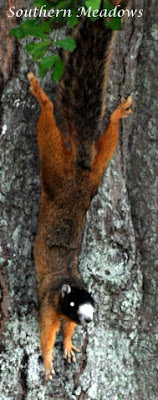Wool Sower Gall
As our habitat garden has grown, there have been new discoveries to be made everyday. Yesterday Mr. Southern Meadows found a weird growth on one of the white maple trees. Was it a fungus, cocoon, gall or something else? It is about the size of a ping pong ball and looks like a cotton ball with pinkish spots. It is spongy but solid. It could almost be a flower as they are located at the end of the branches. Any guesses?
An internet search reveled that it is a gall specific to white oak trees and only found in spring. According the North Carolina Cooperative Extension, Department of Entomology, this wool sower gall (sometimes called the oak seed gall) is caused by secretions of grubs of a small gall wasp, Callirhytis seminator. They lay their eggs in winter and the eggs hatch as new leaves appear on the tree in spring. Chemical secretions from the young grubs stimulate the plant to develop the gall tissue which provides protection to the developing larva and nourishing food.
If one pulls the gall apart (which we did not do) it would reveal seed-like structures. The gall wasps develop inside these structures. Apparently they are never enough numbers to do any harm to the oak trees. We only found two galls on one of our trees. I think parasitic wasps are so incredibly fascinating. They often have pretty complex life-cycles and have co-evolved with their hosts. To see a photo of the parasitic wasp click here.
Have you ever found a gall in your garden?
An internet search reveled that it is a gall specific to white oak trees and only found in spring. According the North Carolina Cooperative Extension, Department of Entomology, this wool sower gall (sometimes called the oak seed gall) is caused by secretions of grubs of a small gall wasp, Callirhytis seminator. They lay their eggs in winter and the eggs hatch as new leaves appear on the tree in spring. Chemical secretions from the young grubs stimulate the plant to develop the gall tissue which provides protection to the developing larva and nourishing food.
If one pulls the gall apart (which we did not do) it would reveal seed-like structures. The gall wasps develop inside these structures. Apparently they are never enough numbers to do any harm to the oak trees. We only found two galls on one of our trees. I think parasitic wasps are so incredibly fascinating. They often have pretty complex life-cycles and have co-evolved with their hosts. To see a photo of the parasitic wasp click here.
Have you ever found a gall in your garden?


.png)
